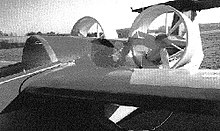Fisherman Whisperfan
| Fischer Whisperfan 6 | |
|---|---|
| Type: | Touring plane |
| Design country: | |
| Manufacturer: |
Fischer flight mechanics |
| First flight: |
n / A |
| Commissioning: |
n / A |
| Number of pieces: |
0 |
The Fischer Whisperfan 6 was designed as a six-seat touring aircraft by Hanno Fischer in the eighties at Rhein-Flugzeugbau (RFB) as an enlarged successor model for the Rhein-Flugzeugbau Fanliner and later further developed at Fischer Flugmechanik . The planned construction of a prototype failed due to the bankruptcy of RFB in 1994.
history
For the Whisperfan, Hanno Fischer developed a completely new jacket screw system with which the noise problem of the previous models was to be eliminated. For this purpose, Fischer developed a new noise-absorbing jacket at Rhein-Flugzeugbau in the mid-1980s, which was to be arranged on the aircraft in such a way that the wings could be used as an additional noise barrier downwards. Together with Karl-Heinz Gronau, Fischer also dealt with the question of the design of the fan sheets under noise aspects. This resulted in the so-called Turkish saber fan, in which the propeller blade was bent in the shape of a Turkish saber. The redesigned jacketed screw drive was named Whisper Fan .
Since Rhein-Flugzeugbau had no funds for prototype testing at the end of the 1980s, Hanno Fischer carried out the practical verification for the Whisper fan in his engineering office Fischer Flugmechanik . The 40-year-old Rhein-Westflug RWF RW-3 prototype D-EKUM was used as the test vehicle, which received a KM871 Wankel engine that was still available at RFB . Two Whisper fans, which were arranged to the right and left of the fuselage rear, replaced the earlier split screw in the tail unit. At the beginning of the nineties, with the RW-3M modified in this way, it was possible to demonstrate a noise reduction of almost 20% as a result of the Whisper fan with doubled engine power.
After completing the development of the Whisper fan, Fischer Flugmechanik came up with a design for a six-person touring aircraft of the same name with a Whisper fan drive. The design of the six-seat Whisperfans included all the technology elements that Hanno Fischer had developed and optimized over forty years, starting with the Fischer-Boretzki FiBo 2 in 1952.
construction
Structurally, the Fischer Whisperfan corresponds to its predecessors Fanliner and Fantrainer with a load-bearing metal structure. Panels and control surfaces are made of GRP construction. The stern consists of a metal shell. Fischer provides various motorization options for one or two motors, which are arranged behind the cabin in the fuselage and drive the two Whisper fans at the rear end of the wing in the transition to the fuselage via long-distance waves. The Whisperfan's cabin design is reminiscent of the design of Rhein-Flugzeugbau RF1 from 1960 with a side door that can be folded up over the entire length of the cabin. For the first time, Fischer is also using a Canard wing with the Whisperfan .
variants
- Fischer Whisperfan 6 - six-seater land version from 1992
- Fischer Whisper-Whale - sea variant on two floats from 2003
- RFB Fanliner FL-5 - planned series variant of the Whisperfan at Rhein-Flugzeugbau
marketing
The planned construction of a prototype should be financed through funds from noise protection programs. Fischer Flugmechanik commissioned the RFB operation in Mönchengladbach with the construction of the prototype, which was also intended for series production under the name Fanliner FL-5. After Rhein-Flugzeugbau went bankrupt, Fischer Flugmechanik initially concentrated on setting up a manufacturing company for the Airfish AF-3 ground-effect vehicles . It was not until the summer of 2003 that Hanno Fischer dealt with the Whisperfan again after John Schwanenberg had signaled his interest in the series production of a sea-based variant of the Whisperfan at the Brandenburg-Briest airfield . Fischer then converted the Whisperfan into a swimmer version under the name Whisper-Whale, while Schwanenberg sought funding from the state of Brandenburg to set up an aircraft construction company. The lengthy efforts ended in 2009 with the closure of Brandenburg-Briest Airport.
Technical specifications
| Parameter | Whisperfan | Whisper-Whale |
|---|---|---|
| crew | 6th | |
| length | 9.00 m | |
| span | 12.00 m | |
| height | 2.62 m | |
| Wing area | 17.80 m² | |
| Max. Takeoff mass | 2140 kg | 2477 kg |
| Top speed | 318 km / h | 241 km / h |
| Range | 2304 km | 1500 km |
| Engines | 2 × 210 PS Lycoming IO-360 2 × 200 PS Mazda Wankel 1 × 425 PS Lycoming TIGO-541E 1 × 375 PS Continental GTSIO-520 |
|
See also
literature
- Paul Zöller: Rhein-Flugzeugbau GmbH and Fischer Flugmechanik . 1st edition, 2016, ISBN 978-3-7431-1823-2
Individual evidence
- ↑ Hanno Fischer: Training of components lying in the influx of propellers, jacket screws and / or fans to reduce the additional noise they cause . DE3605086 A1, February 18, 1986 ( google.com [accessed July 22, 2017]).
- ↑ Hanno Fischer: Propeller for propelling an aircraft . DE3801353 C1, January 19, 1988 ( google.com [accessed July 22, 2017]).
- ↑ Measurement protocols, Fischer flight mechanics
- ↑ Berliner Zeitung, March 26, 2003, An entrepreneur wants to build new types of flying boats in Briest
- ^ Fischer flight mechanics: Whisper-Whale project study, 2005
